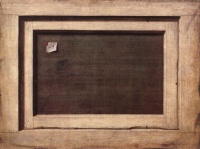Imaginary painting
From The Art and Popular Culture Encyclopedia
(Difference between revisions)
| Revision as of 17:06, 17 September 2012 Jahsonic (Talk | contribs) ← Previous diff |
Revision as of 17:07, 17 September 2012 Jahsonic (Talk | contribs) Next diff → |
||
| Line 2: | Line 2: | ||
| [[Image:Reverse Side Of a Painting.jpg|thumb|right|200px|''[[Reverse Side Of a Painting]]'' (1670) by [[Cornelis Norbertus Gysbrechts]]. Is the [[Recto and verso |verso]] of a fictional painting?]] | [[Image:Reverse Side Of a Painting.jpg|thumb|right|200px|''[[Reverse Side Of a Painting]]'' (1670) by [[Cornelis Norbertus Gysbrechts]]. Is the [[Recto and verso |verso]] of a fictional painting?]] | ||
| {{Template}} | {{Template}} | ||
| - | A '''fictional painting''' or an '''imaginary painting''' is a painting which exists in a [[fictitious world]]. It may also refer to paintings or drawings that depict [[fictitious world]]s. | + | A '''fictional painting''' or an '''imaginary painting''' is a painting which exists in a [[fictitious world]]. It may also refer to paintings or drawings that depict [[fictitious world]]s. This page functions as a [[placeholder]] for various links. |
| ==Examples== | ==Examples== | ||
Revision as of 17:07, 17 September 2012

Reverse Side Of a Painting (1670) by Cornelis Norbertus Gysbrechts. Is the verso of a fictional painting?
|
Related e |
|
Featured: |
A fictional painting or an imaginary painting is a painting which exists in a fictitious world. It may also refer to paintings or drawings that depict fictitious worlds. This page functions as a placeholder for various links.
Contents |
Examples
In literature
Nicholas Meyer's 1993 novel The Canary Trainer describes a fictional painting by the famous Impressionist Degas, which happens to show Sherlock Holmes.
In Interpretazioni veneziane, Michelangelo Muraro and David Rosand state that:
- Certainly the imagery that Aretino describes at the beginning of the Passion carries conviction. ... has stimulated commentators to suggest that Aretino is describing an imaginary painting by Titian or Tintoretto. ...
In painting
- Ancient Rome (painting) by Panini
- Imaginary galleries
In film
See also
Unless indicated otherwise, the text in this article is either based on Wikipedia article "Imaginary painting" or another language Wikipedia page thereof used under the terms of the GNU Free Documentation License; or on research by Jahsonic and friends. See Art and Popular Culture's copyright notice.


